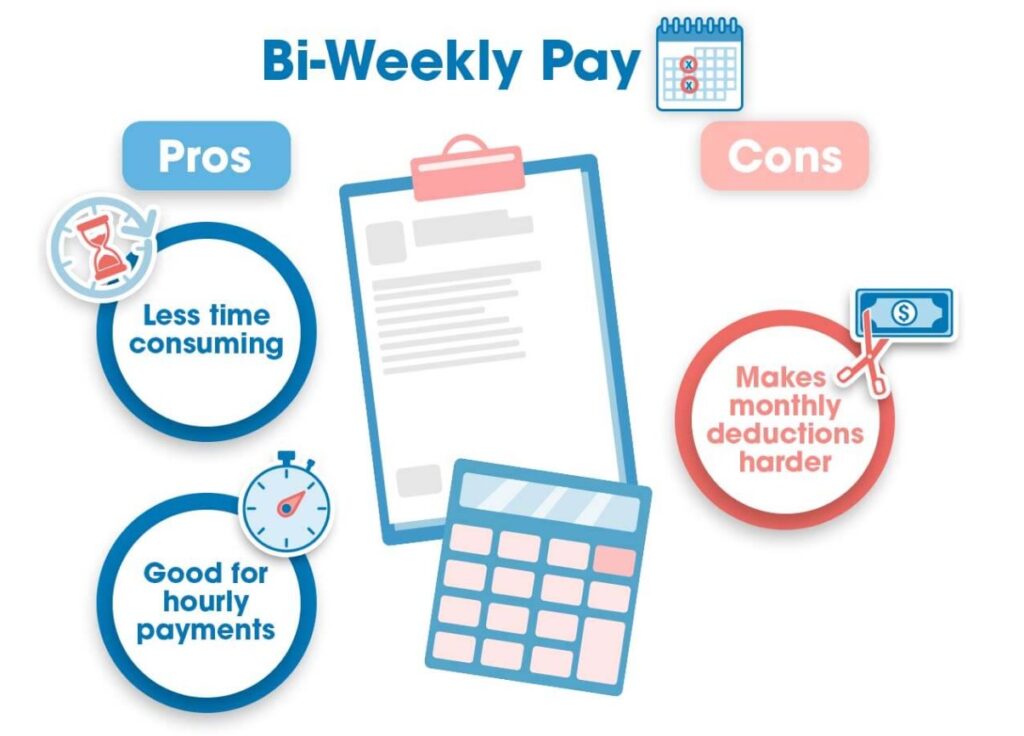What is Biweekly pay?
Biweekly pay is a compensation system where employees receive their wages every two weeks, resulting in a total of 26 pay periods per year. This payment structure is widely adopted by many organizations as it offers a consistent and regular income stream for employees. The biweekly pay calculation is typically based on an employee’s hourly rate multiplied by the number of hours worked over a two-week period, adjusted for any deductions such as taxes and benefits. Its different from Semi monthly pay.
Semi-monthly pay refers to a payment system where employees are paid twice a month, usually on specific dates such as the 15th and the last day of the month. With semi-monthly pay, employees receive 24 paychecks per year. The key difference between biweekly and semi-monthly pay lies in the frequency of payments and the total number of pay periods in a year. While both systems aim to provide employees with regular and consistent income, biweekly pay offers more frequent payments but results in slightly smaller individual paychecks compared to semi-monthly pay.
How is it calculated?
Biweekly pay is typically calculated by multiplying an employee’s hourly rate by the number of hours worked in a two-week period. This amount is then adjusted for any deductions, such as taxes and benefits, to determine the net pay.

Pros of Biweekly Pay: Employee’s Perspective
26 Paychecks Per Year
One of the significant benefits of biweekly pay is that employees receive 26 paychecks per year. This frequency allows for better financial planning and can help employees cover monthly expenses more efficiently.
More Money More Often
With biweekly pay, employees get paid more frequently, which can provide a steady stream of income to meet ongoing financial obligations.
More Money to Save
The regular pay schedule of biweekly pay can also encourage employees to save more consistently, helping them achieve their financial goals faster.
Cons of Bi-Weekly Pay: Employee’s Perspective
Difficulty With Budgeting
The biweekly pay schedule can make budgeting challenging for some employees, as they have to manage their expenses over a longer period between paychecks.
Pressure to Use Their Pay On Vacation
Employees might feel pressured to use their paychecks for vacations or other non-essential expenses due to the longer pay period.
Likely to Be Paid Less
On a biweekly pay schedule, employees might receive smaller individual paychecks compared to a weekly or semi-monthly pay schedule.
Harder Time Managing Expenses
The longer pay period between biweekly paychecks can make it harder for employees to manage their monthly expenses effectively.
Pros of Bi-Weekly Pay: Employer’s Perspective
More Compressed Scheduling
Biweekly pay allows employers to have a more compressed scheduling system, which can lead to increased productivity and efficiency.
Tax Planning for Employer
The biweekly pay schedule also offers advantages for employers in tax planning and cash flow management.
More Accurate Scheduling
With biweekly pay, employers can more accurately predict and schedule payroll, reducing errors and ensuring timely payments.
Save on Costs
Employers can save on administrative costs associated with payroll processing by adopting a biweekly pay schedule.
Adjustments to Employee Behavior
The biweekly pay schedule can also influence positive changes in employee behavior, such as improved attendance and punctuality.
Cons of Bi-Weekly Pay: Employer’s Perspective
Can be Harder to Budget
Employers might find it challenging to budget for larger biweekly payroll expenses compared to more frequent pay schedules.
Confusing for New Employees
New employees may find the biweekly pay schedule confusing initially, leading to questions and potential misunderstandings.
Check Cashing Fees
Employees who don’t have bank accounts may incur check cashing fees more frequently with a biweekly pay schedule.
Harder to Assess Performance
With a longer pay period, employers might find it harder to assess employee performance and provide timely feedback.
Understanding the nuances between biweekly and semi-monthly pay is essential for effective financial planning and budget management. While biweekly pay results in 26 paychecks per year with slightly smaller individual amounts, semi-monthly pay provides 24 paychecks annually but with larger amounts per paycheck. The choice between these two pay structures can significantly impact an individual’s cash flow and financial strategies. For a more detailed comparison and insights into reading pay stubs for both payment systems, you can refer to the following resources:
Frequently Asked Questions
Is biweekly pay better than monthly pay?
Biweekly pay can offer benefits like more frequent paychecks and better financial planning, but the best option depends on individual preferences and financial situations.
How does biweekly pay affect taxes?
Biweekly pay can impact tax withholding amounts, requiring employees and employers to adjust tax calculations accordingly.
Can I negotiate my pay schedule with my employer?
Yes, employees can discuss and negotiate their pay schedule with their employers, but it ultimately depends on the company's policies and payroll systems.
Are there any legal requirements for biweekly pay?
Employers must comply with federal and state laws regarding minimum wage, overtime pay, and pay frequency when implementing a biweekly pay schedule.
How can I manage my finances with a biweekly pay schedule?
Effective budgeting, saving, and planning can help employees manage their finances more efficiently with a biweekly pay schedule.
What are some alternatives to biweekly pay?
Alternatives to biweekly pay include weekly pay, semi-monthly pay, and monthly pay, each with its own set of pros and cons.
Conclusion
In conclusion, biweekly pay offers a structured and consistent compensation system for employees, resulting in 26 paychecks per year and aiding in better financial planning. While it has its advantages in terms of regularity and predictability, it may also present challenges for some individuals in budgeting and managing expenses. Employers benefit from more compressed scheduling and potential cost savings, but may face difficulties in budgeting larger payroll expenses. To delve deeper into the intricacies of payroll management and its impact on both employers and employees, you can explore resources from authoritative sources such as the U.S. Department Of Labor and the Internal Revenue Service.